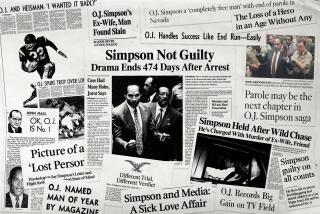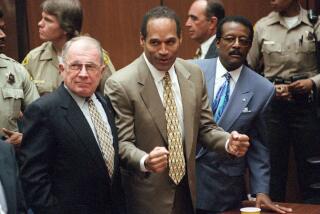Sept. 11 artist will use dirt to paint a unified portrait
- Share via
Reporting from Seoul — Kazakhstan was becoming a problem. Gary Simpson had already failed once to get his package out of that country through an operative there. Now came more bad news.
Kazakh customs officials had confiscated the latest shipment, Simpson’s contact emailed. “They are very suspicious and think there are ulterior motives intended to undermine state security or foment revolt.”
Simpson sighed. This wasn’t any top-secret government file, just an airmail parcel containing 2 pounds of dirt.
The Orange County conceptual artist was hunting raw materials for his latest venture, a 50-by-50-foot swath of Abstract Expressionism using soil from each of the 193 member countries of the United Nations.
After the terrorist attacks of Sept. 11, 2001, Simpson decided he wanted to look past language, cultural and religious barriers to focus on what people had in common. They all stood on the same soil.
He calls his concept “Common Ground 191” for the number of U.N. members when he began the project, before the additions of Montenegro and South Sudan.
He plans to mix the dirt with concrete and pigment to create 196 panels, 42 inches by 42 inches apiece, one for each nation, with a few left for discretionary use. The work will eventually depict an abstract multihued landscape that Simpson says will contain symbols of humanity’s past and future.
Dreaming up the idea was simple; carrying through hasn’t been. “I was naive,” said Simpson, 63, a burly, white-bearded man. “I mean, it may be mere dirt, but you can’t just send it from here to there. Oh, no.”
His soil collection drive became a years-long odyssey involving crabby customs officials, fine-print regulations and byzantine bureaucracies, not the least of which were in his own country. His dirt shipments have been scrutinized by the U.S. Department of Agriculture, which baked each sample at 500 degrees for 45 minutes to remove any contaminants.
When it came to the troublesome list of nations under U.S. embargoes, such as Cuba, Syria and Iran, the Treasury Department’s Foreign Assets Control office got involved. From its perspective, the soil was a potential asset, which required a special license to collect.
Simpson couldn’t afford to go and fetch the dirt himself. It came to him through a phalanx of vacationers, vagabonds, workers for nongovernmental organizations, inspired locals and some 60 embassy officials. They were people who either immediately grasped Simpson’s vision or were keen for a bit of adventure. Simpson calls them “quiet crusaders.”
Since 2002, the artist says, he has logged 12,000 hours and spent $250,000 on his project — including $25,000 on postage alone — mostly through loans and money earned through his art sales.
Working the phones, writing letters, coordinating volunteers, Simpson built up his soil bank slowly, patiently crossing off each contributing country like an inmate marking time. Finally, only one nation remained: North Korea.
Simpson had little hope of piercing the isolationist regime. But then he got lucky. He met a travel agent who did business with Pyongyang and who persuaded officials to permit the taking of a sample.
This was one trip the artist knew he had to make himself. Simpson recently sat in an airport lounge in Seoul on his way to Pyongyang, and it was clear that the years of work haven’t dimmed his enthusiasm. “This is for Kim Jong Il,” he said, producing a vial of Common Ground dirt from numerous nations he wanted to present to the reclusive North Korean leader as a gesture. “Do you think I can get it to him?”
*
The samples were collected in nations at peace and at war. Simpson recalls the U.S. helicopter pilot who scooped up soil from Iraq in 2005.
Simpson’s volunteer collector approached the pilot in Kuwait, who offered to set down his chopper in the Iraqi desert. The collector later wrote Simpson of the exchange: “ ‘Are you crazy? I mean, they’re shooting helicopters down right and left, and you’re going to stop for dirt?’ So he stopped in Basra, just for the dirt.”
Simpson’s website, https://www.commonground191.com, documents “the torturous route that the soil must take to reach the artist.”
The gathered soil is as varied as its sources — orange sand from Qatar, black loam from Bulgaria, rich soil from former slave-trading ports in Cape Verde. The samples are pink, gray, brown and red — some dull, others twinkling with fool’s gold.
Some samples carry only general explanations of where they came from: a “coastal area in Australia,” “forest by a train station in Belarus,” “a deserted house in Luxembourg” and “the home of a friend in Croatia.”
Others have poignant cultural significance, such as ashen earth from the Auschwitz concentration camp in Poland that the collector described as “downbeat soil.” There is dirt from the ancient Maya ruins of Chichen Itza in Mexico’s Yucatan; the South African prison where Nelson Mandela languished; the home of Chilean writer Pablo Neruda; and Egypt’s Tahrir Square, where a medical student named Nehal took pictures of herself in February scooping up the grit as protesters flooded the now-famous plaza.
Simpson even talked a Los Angeles County sheriff’s deputy on a special security detail into collecting soil from the White House grounds during President Obama’s 2009 inauguration.
There were setbacks. One Armenian customs official balked at the declared 25-cent value of the soil, which, Simpson says, “offended his sense of nationalism.” (The package got through on a second try.) The Kazakh dirt, taken from the home of the composer who penned the national anthem, finally got out via a U.S. Embassy diplomatic pouch.
The collecting cost more than Simpson anticipated. Now he needs additional sponsors to raise $90,000 to pay for materials and rent a large space to construct the work.
There was also the loss of his biggest emotional backer: his dad. With the son averse to computers, the father ran the spreadsheets needed to track the quest. When his father, Robert, died this spring at 92, Simpson made him a permanent part of the piece. His ashes will now be included in one of the discretionary panels.
He still feels his father’s guiding hand: This summer, scratching for the $8,000 to go to North Korea, Simpson got a call from a donor who’d seen his online request for funding.
“You’re going to Pyongyang,” she said. It was his dad’s birthday.
*
The North Koreans may have been skeptical, but one official handed Simpson his soil, collected from a site known as Freedom Tower.
Back home at Simpson’s Santa Ana studio, the dirt was added to the others stored on shelves, each bearing an image of the country’s flag. Sometimes Simpson takes one down to slowly sift its contents, like an old prospector.
One day, he would like to see parts of his finished project displayed at embassies worldwide, perhaps one removable panel at each site. Then he laughs at the lofty goal, displaying a list of politicians he wrote for help getting into North Korea.
“Some didn’t even respond,” he said. “I’m sure they all thought I was nuts. But I don’t hold anything against them.”
More to Read
Sign up for Essential California
The most important California stories and recommendations in your inbox every morning.
You may occasionally receive promotional content from the Los Angeles Times.














